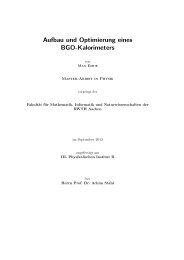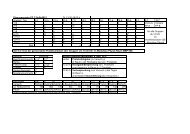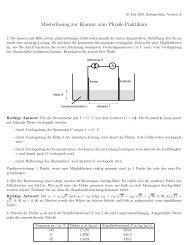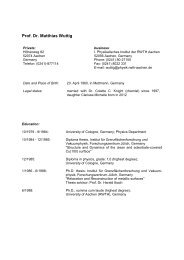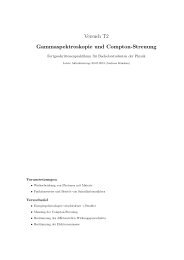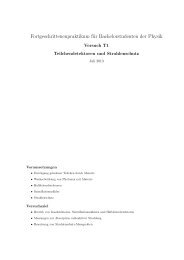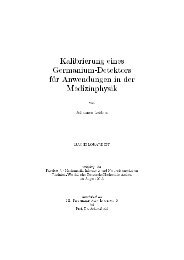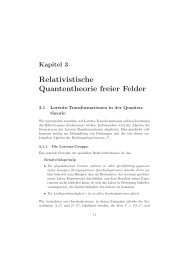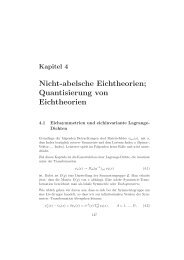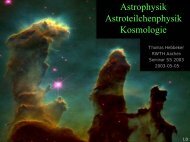Spectral analysis, perturbation theory, and applications to molecular ...
Spectral analysis, perturbation theory, and applications to molecular ...
Spectral analysis, perturbation theory, and applications to molecular ...
You also want an ePaper? Increase the reach of your titles
YUMPU automatically turns print PDFs into web optimized ePapers that Google loves.
Faculty of Science Institute for Theoretical Physics, Condensed Matter Theory<br />
The master equation for nanoscopic transport:<br />
<strong>Spectral</strong> <strong>analysis</strong>, <strong>perturbation</strong> <strong>theory</strong>, <strong>and</strong><br />
<strong>applications</strong> <strong>to</strong> <strong>molecular</strong> devices<br />
Carsten Timm<br />
source<br />
drain<br />
gate<br />
Spin-Orbit <strong>and</strong> Interaction Effects in Nano-Electronics<br />
04.02.-06.02.2013
Overview<br />
• The master equation<br />
• Perturbative expansion of Pauli master equations<br />
• Spectrum of the transition-rate matrix<br />
• Realistic modeling for N@C 60<br />
• Summary
Overview<br />
• The master equation<br />
• Perturbative expansion of Pauli master equations<br />
• Spectrum of the transition-rate matrix<br />
• Realistic modeling for N@C 60<br />
• Summary
Quantum master equation(s)<br />
source<br />
drain<br />
gate<br />
metal, semiconduc<strong>to</strong>r…<br />
Small system (“dot”) coupled <strong>to</strong> large reservoirs, out of equilibrium<br />
local dot observable<br />
current
only depends on the dot:<br />
with reduced density opera<strong>to</strong>r (in “small” dot Fock space)<br />
basis of lead states only<br />
Only useful if we can find an equation of motion for<br />
Master Equation<br />
Derivation starts from the exact von Neumann equation<br />
with the Liouvillian superopera<strong>to</strong>r
Projection on<strong>to</strong> relevant states: projection superopera<strong>to</strong>rs<br />
with<br />
relevant part<br />
Example (a):<br />
irrelevant part<br />
leads in (separate) equilibrium;<br />
actual lead state ignored;<br />
same information as<br />
Example (b):<br />
master equations<br />
for <strong>and</strong> ?<br />
diagonal projection: consider only<br />
diagonal components of<br />
(probabilities )<br />
→ Pauli master equation<br />
cf. R. Zwanzig, J. Chem. Phys. 33,<br />
1338 (1960)
More specifically:<br />
Hamil<strong>to</strong>nian<br />
Liouvillian<br />
source<br />
drain<br />
• includes local interactions<br />
(Coulomb, electron-vibron, electron-spin)<br />
gate<br />
• hybridization between dot state <strong>and</strong> lead state in lead :<br />
: bilinear hopping term
1. Nakajima-Zwanzig master equation<br />
S. Nakajima, Prog. Theor. Phys. 20, 948 (1958);<br />
R. Zwanzig, J. Chem. Phys. 33, 1338 (1960); Physica 30, 1109 (1964)<br />
allow time-dependent tunneling, specifically switching<br />
with rate<br />
von Neumann equation<br />
<strong>and</strong><br />
solve second equation for , assume , insert in<strong>to</strong> first equation…<br />
see, e.g., Breuer <strong>and</strong> Petruccione, The Theory of Open Quantum Systems<br />
(Oxford)
Nakajima-Zwanzig master equation<br />
bare time evolution<br />
exact equation of motion for the relevant part<br />
alone<br />
note the integro-differential form<br />
memory kernel
• stationary state:<br />
• non-stationary state but “poor memory”:<br />
decays rapidly with<br />
“Nakajima-Zwanzig-Markov”<br />
(NZM) genera<strong>to</strong>r<br />
Perturbation <strong>theory</strong> <strong>to</strong> arbitrary order: equivalent <strong>to</strong> real-time diagrammatics<br />
of Schoeller, Schön, König [PRB 50, 18436 (1994); EPL 31, 31 (1995); PRL<br />
76, 1715 (1996)], see C.T., PRB 77, 195416 (2008)
2. Time-convolutionless (TCL) master equation<br />
Tokuyama <strong>and</strong> Mori, Prog. Theor. Phys. 55, 411 (1976); Hashitsume et al., J.<br />
Stat. Phys. 17, 155 (1977); see also Breuer <strong>and</strong> Petruccione, The Theory of<br />
Open Quantum Systems (Oxford)<br />
beyond Nakajima-Zwanzig:<br />
make equation local in time by propagating backward (exactly)<br />
requires additional<br />
perturbative expansion
TCL master equation<br />
with<br />
is of the form
Overview<br />
• The master equation<br />
• Perturbative expansion of Pauli master equations<br />
• Spectrum of the transition-rate matrix<br />
• Realistic modeling for N@C 60<br />
• Summary
Perturbative expansion of Pauli master equations<br />
Nakajima-Zwanzig-Markov (NZM) <strong>and</strong> time-convolutionless (TCL) equations<br />
can be derived for diagonally projected density opera<strong>to</strong>r<br />
→ Pauli master equations, C.T., PRB 83, 115416 (2011)<br />
• TCL genera<strong>to</strong>r<br />
can be expressed in terms of T-matrix genera<strong>to</strong>r<br />
• TCL genera<strong>to</strong>r regular for <strong>to</strong> all orders, divergences cancel<br />
[di<strong>to</strong> for NZM genera<strong>to</strong>r, for 4 th order shown by S. Koller et al., Phys.<br />
Rev. B 82, 235307 (2010)]<br />
• explicit construction of all expansion terms of TCL genera<strong>to</strong>r<br />
(also of NZM genera<strong>to</strong>r), first two terms:<br />
TCL correction<br />
correction is relevant close <strong>to</strong> Coulomb-blockade threshold
Perturbative expansion of Pauli master equations<br />
Nakajima-Zwanzig-Markov (NZM) <strong>and</strong> time-convolutionless (TCL) equations<br />
can be derived for diagonally projected density opera<strong>to</strong>r<br />
→ Pauli master equations, C.T., PRB 83, 115416 (2011)<br />
• TCL <strong>and</strong> NZM master equations agree for stationary states (as they should)<br />
• … but only if full <strong>perturbation</strong> series is summed up, not at finite order > 2<br />
To do:<br />
• physical relevance for realistic model<br />
• TCL master equation without diagonal projection
Overview<br />
• The master equation<br />
• Perturbative expansion of Pauli master equations<br />
• Spectrum of the transition-rate matrix<br />
• Realistic modeling for N@C 60<br />
• Summary
Spectrum of the transition-rate matrix<br />
master equation can be written in superopera<strong>to</strong>r form as<br />
eigenvalues of A describe dynamics of open system <strong>and</strong> are interesting:<br />
A. Donabidowicz-Kolkowska, <strong>and</strong> C.T., New J. Phys. 14, 103050 (2012)<br />
Ansatz<br />
eigenvalue equation for eigenvalues ®<br />
• solution decays with rate<br />
• … <strong>and</strong> oscillates with frequency<br />
• one eigenvalue is<br />
→ eigen“vec<strong>to</strong>r” ³ 0 is stationary state
Spectrum of the transition-rate matrix<br />
Model: molecule with electrons coupled <strong>to</strong> vibrational mode, coupled <strong>to</strong> leads<br />
for large electron-vibron coupling find Franck-Condon blockade since lowenergy<br />
vibrational eigenstates for different charge overlap weakly<br />
Koch, von Oppen, PRL 94, 206804 (2005):<br />
dI/dV very small<br />
at low bias
Spectrum of the transition-rate matrix<br />
does the eigenvalue spectrum of A show characteristic differences between<br />
• transmitting dot<br />
• Coulomb blockade<br />
• Franck-Condon blockade<br />
master equation, <strong>perturbation</strong> <strong>theory</strong> <strong>to</strong> leading order:<br />
• exp<strong>and</strong> <strong>to</strong> second order in<br />
or<br />
• send<br />
• secular approximation: for degenerate eigenvalues of , choice of basis<br />
in degenerate subspace is arbitrary → diagonal (Pauli) projection unjustified<br />
→ keep off-diagonal components of<br />
connecting degenerate states<br />
non-secular components lead <strong>to</strong> fast processes;
Transmitting dot (on resonance), weak electron-vibron coupling ¸ = 1<br />
stationary state<br />
spectrum<br />
current<br />
vibrational quantum number<br />
charge<br />
• gap in spectrum – no very slow modes<br />
• slowest decaying modes at small V : threefold generate, spin polarizations
Coulomb blockade, weak electron-vibron coupling ¸ = 1<br />
stationary state<br />
spectrum<br />
current<br />
vibrational quantum number<br />
charge<br />
• gap closes – very slow modes<br />
• slowest decaying modes at small V : spin polarizations<br />
very slow since one electron must tunnel out, another one in
Deep Coulomb blockade, weak electron-vibron coupling ¸ = 1<br />
stationary state<br />
spectrum<br />
current<br />
vibrational quantum number<br />
charge<br />
• deep in the Coulomb blockade more modes become slow:<br />
excited-state-<strong>to</strong>-excited-state transitions become blocked<br />
• slow modes are mostly vibrational excitations
Franck-Condon blockade (on resonance), strong electron-vibron coupling ¸ = 4<br />
stationary state<br />
spectrum<br />
current<br />
vibrational quantum number<br />
charge<br />
• many slow modes (exponentially small Franck-Condon matrix elements)<br />
• slowest decaying modes are vibrational excitations
Overview<br />
• The master equation<br />
• Perturbative expansion of Pauli master equations<br />
• Spectrum of the transition-rate matrix<br />
• Realistic modeling for N@C 60<br />
• Summary
Realistic modeling for endohedral N@C 60<br />
nitrogen retains spin S N = 3/2 (Hund‘s 1 st rule), essentially isotropic<br />
break-junction experiment motivated by F. Elste <strong>and</strong> C.T., PRB 71, 155403<br />
(2005)<br />
J. E. Grose, E. Tam, C.T., M.<br />
Scheloske, B. Ulgut, J. J. Parks, H. D.<br />
Abruña, W. Harneit, <strong>and</strong> D. C. Ralph,<br />
Nature Materials 7, 884 (2008)<br />
• production by ion implantation <strong>and</strong><br />
enrichment: Harneit group, FU Berlin<br />
• device fabrication, measurements:<br />
Ralph group, Cornell<br />
• <strong>theory</strong>: C.T.
Bias Voltage [V]<br />
Bias Voltage [V]<br />
Differential conductance: experiment<br />
B = 0T<br />
Vg = -890 mV<br />
0.00500<br />
0.00500<br />
0.00375<br />
0.00375<br />
0.00250<br />
0.00250<br />
0.00125<br />
CB<br />
0.00125<br />
0.00000<br />
-0.00125<br />
CB<br />
0.00000<br />
-0.00125<br />
CB<br />
kinks<br />
-0.00250<br />
-0.00375<br />
-0.00250<br />
-0.00375<br />
-905 -900 -895 -890 -885 -880<br />
Gate Voltage [mV]<br />
0 1250 2500 3750 5000 6250 7500<br />
Magnetic Field [mT]<br />
0 1 2 3 4 5<br />
Conductance [uS]<br />
-2.0 0.0 2.0 4.0<br />
Conductance [uS]
Modeling<br />
Coulomb repulsion on C 60<br />
local potential (asym. coupling)<br />
exchange between electron <strong>and</strong> N spin<br />
N = 1, s e = 1/2, S = 2<br />
E<br />
E<br />
N = 1, s e = 1/2, S = 1<br />
2|J|<br />
2|J|<br />
N = 2, s e = 0, S = 3/2<br />
-2 -1 0<br />
1<br />
2<br />
m<br />
-2 -1 0<br />
1<br />
2<br />
m
a<br />
a b c<br />
N = 1<br />
E<br />
D<br />
C<br />
B<br />
A<br />
Calculations: master equation<br />
• sequential tunneling (second order in )<br />
b c<br />
• Pauli master equation (stationary state is<br />
N = 2<br />
diagonal, no additional assumption)<br />
• model parameters from experiment<br />
Fine structure: Very soft oscillations?<br />
2|J|<br />
E<br />
-2 -1 0<br />
C<br />
D<br />
C<br />
B<br />
1<br />
A<br />
E<br />
2<br />
E<br />
D<br />
B<br />
m<br />
C<br />
A<br />
b<br />
c<br />
c<br />
b<br />
a<br />
a<br />
-2 -1 0<br />
1<br />
2<br />
m
experiment<br />
<strong>theory</strong><br />
0.00500<br />
0.00375<br />
0.00250<br />
0.00500<br />
0.00375<br />
0.00250<br />
0.00125<br />
0.00000<br />
-0.00125<br />
-0.00250<br />
-0.00375<br />
additional<br />
physics<br />
-905 -900 -895 -890 -885 -880<br />
0.00125<br />
0.00000<br />
-0.00125<br />
-0.00250<br />
-0.00375<br />
0 1250 2500 3750 5000 6250 7500
Sequential <strong>and</strong> cotunneling through N@C 60<br />
N. Roch, R. Vincent, F. Elste, W. Harneit, W. Wernsdorfer, C.T., <strong>and</strong> F. Balestro,<br />
Phys. Rev. B 83, 081407(R) (2011)<br />
exp<br />
th<br />
exp<br />
th<br />
• reproduce experiment of Grose et al.—not trivial in this field<br />
• observe inelastic cotunneling due <strong>to</strong> spin flip<br />
• calculate cotunneling in picture of Grose et al. (N = 1 <strong>to</strong> 2, J < 0)
Thanks <strong>to</strong><br />
Agnieszka Donabidowicz-Kolkowska<br />
TU Dresden<br />
Tim Ludwig<br />
TU Dresden<br />
Thomas Brumme TU Dresden<br />
Stefan Lange<br />
TU Dresden → PIK<br />
Massimiliano Di Ventra UC San Diego<br />
Binhe Wu<br />
Donghua U, Shanghai<br />
Guichao Hu<br />
Sh<strong>and</strong>ong Normal U<br />
Jens Kortus<br />
TUBA Freiberg<br />
Torsten Hahn<br />
TUBA Freiberg<br />
Florian Elste<br />
Columbia U → Deutsche Bank<br />
Felix von Oppen FU Berlin<br />
Daniel C. Ralph<br />
Cornell U<br />
Wolfgang Wernsdorfer CNRS Grenoble<br />
Christian Hess<br />
IFW Dresden<br />
FOR 1154<br />
Towards Molecular<br />
Spintronics
Summary<br />
source<br />
drain<br />
• The master equation<br />
Nakajima-Zwanzig-Markov vs. time-convolutionless<br />
gate<br />
• Perturbative expansion of Pauli master equations<br />
TCL Pauli master equation converges order by order<br />
agrees with Nakajima-Zwanzig-Markov only <strong>to</strong> 2 nd order<br />
• Spectrum of the transition-rate matrix<br />
…for Franck-Condon system: characteristic of dynamics<br />
• Realistic modeling for N@C 60<br />
break-junction experiments (Ralph, Wernsdorfer)<br />
can be described quantitatively
Spin relaxation <strong>and</strong> amplification<br />
molecules with magnetic<br />
anisotropy<br />
Mn 12<br />
cluster<br />
Co-phthalocyanine<br />
easy-axis<br />
anisotropy<br />
anisotropy → energy<br />
barrier for spin reversal<br />
→ slow spin relaxation<br />
C.T. <strong>and</strong> F. Elste, PRB<br />
73, 235304 (2006)
apid intermediate Toward memory devices slow<br />
gate<br />
ac bias voltage<br />
C.T. <strong>and</strong> M. Di Ventra,<br />
in progress
dI/dV<br />
Anisotropy <strong>and</strong> magnetic field<br />
dI/dV for arbitrary orientation of magnetic<br />
field vs. easy axis—usually unknown<br />
terms do not commute<br />
→ no conserved quantities<br />
except electron number<br />
→ degeneracies lifted <strong>and</strong><br />
many allowed transitions<br />
C.T., PRB 76, 014421 (2007)
Anisotropy <strong>and</strong> magnetic field<br />
dI/dV for arbitrary orientation of magnetic<br />
field vs. easy axis—usually unknown<br />
dI/dV<br />
terms do not commute<br />
→ no conserved quantities<br />
except electron number<br />
→ degeneracies lifted <strong>and</strong><br />
many allowed transitions<br />
C.T., PRB 76, 014421 (2007)
STM modeling for large U<br />
with T. Ludwig (TUD), J. Kortus <strong>and</strong> T. Hahn<br />
(TUBA Freiberg)<br />
strong interactions,<br />
sharp <strong>molecular</strong> levels<br />
• insulating layer, e.g., NaCl<br />
• lig<strong>and</strong>s as tunneling barriers<br />
• probably for HOPG substrate (→ IFW)<br />
usual (Green-function) approaches fail<br />
Goal: Master equation with dependence<br />
on tip position<br />
• model for molecule <strong>and</strong> substrate based<br />
on DFT (energies <strong>and</strong> orbitals)<br />
• Bardeen approach++ → tunnel matrix<br />
elements tip–molecule, tip–substrate<br />
metal, semiconduc<strong>to</strong>r…<br />
related work:<br />
Sobczyk et al., PRB 85, 205408 (2012);<br />
Donarini et al., arXiv:1206.2664
Example: Co- <strong>and</strong> Mn-phthalocyanine<br />
Co II<br />
Mn II
CoPC<br />
MnPC<br />
• tip height<br />
(over Mn/Co)<br />
h = const<br />
• scale: nm<br />
h = 1 Å<br />
h = 1 Å<br />
• here no substrate<br />
structure<br />
• CoPC, MnPC:<br />
different HOMOs<br />
• MnPC Jahn-<br />
Teller dis<strong>to</strong>rted<br />
h = 10 Å<br />
h = 10 Å
MnPc with model substrate<br />
constant current, I = const<br />
proof of principle:<br />
many-particle-approach<br />
with Coulomb blockade<br />
<strong>and</strong> spatial resolution<br />
experiments in<br />
progress<br />
Hess, Büchner<br />
(IFW Dresden)





